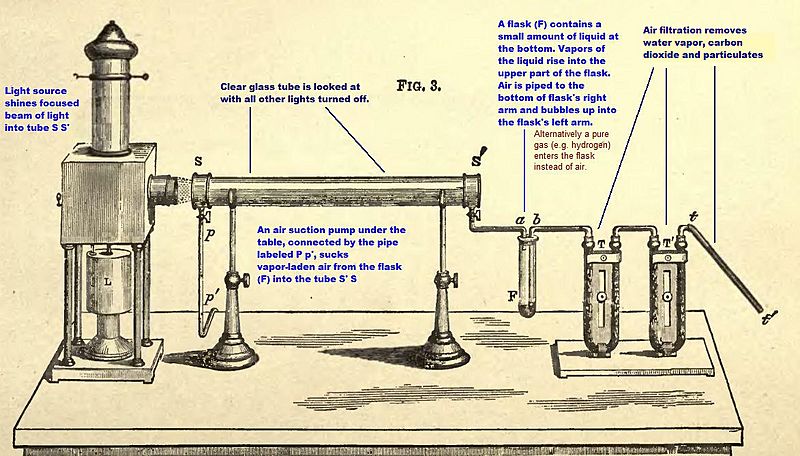Image: Tyndall setup for looking at aerosols

Description: John Tyndall's illustration of his setup for looking at aerosols (1868), subsequently annotated in colored typeface. The above apparatus is meant to be looked at in a dark room, i.e., a room with no light except for the illuminated glass tube at the center of the picture. Its basic idea is to bring a chemical vapor into the illuminated glass tube by a suction pump (the suction pump is under the table). The illustration dates from 1868. With this apparatus John Tyndall found that a variety of vapors, initially clear and transparent to light, became cloudy with more exposure to the light due to chemical decomposition of the vapor molecules. He verified that it was the light itself that caused this decomposition. The chemical reaction in response to the light was in some cases rapid (e.g. when the vapor was amyl nitrite) and in other cases very gradual (e.g. when the vapor was isopropyl iodide). Some vapors formed white clouds, others formed blue or purple clouds. The clouds took on distinctive shapes and swirled in "paroxysms of motion", in some cases. Tyndall demonstrated that the particular wavelengths that produced a photochemical decomposition depended on the particular type of vapor molecule that was decomposed, although in all cases the light was predominantly or exclusively in the blue and near UV area. Tyndall uses these photochemical reactions as context for talking about the question of the mechanism by which molecules absorb radiant energy. The illustration is in Tyndall's report "New Chemical Reactions Produced by Light" (1868) and again in Tyndall's "On the Action of Rays of High Refrangibility upon Gaseous Matter" (1870). It is also included in the later editions of his book Heat as a Mode of Motion even though it is not a heat phenomenon.
Title: Tyndall setup for looking at aerosols
Credit: The illustration appears in John Tyndall's book "Fragments of Science, Volume One" and has been taken from a copy of the book at Archive.org.
Author: John Tyndall's commissioned drawer (anon)
Usage Terms: Public domain
License: Public domain
Attribution Required?: No
Image usage
The following page links to this image:

